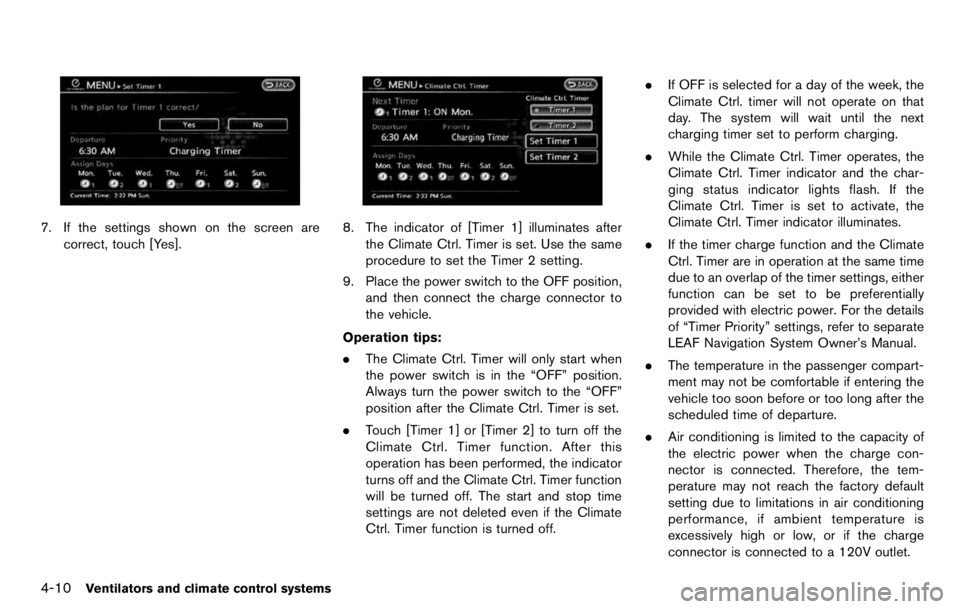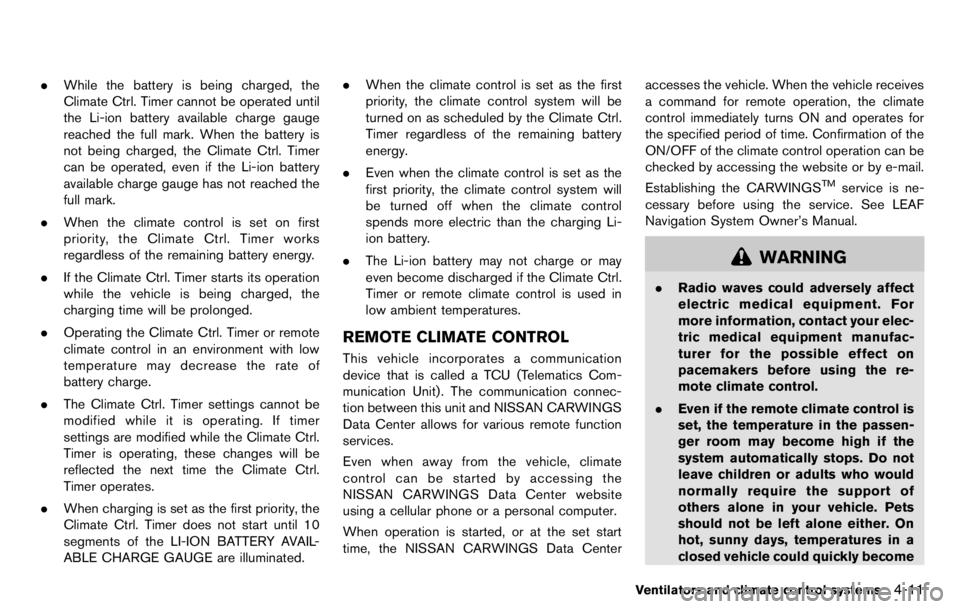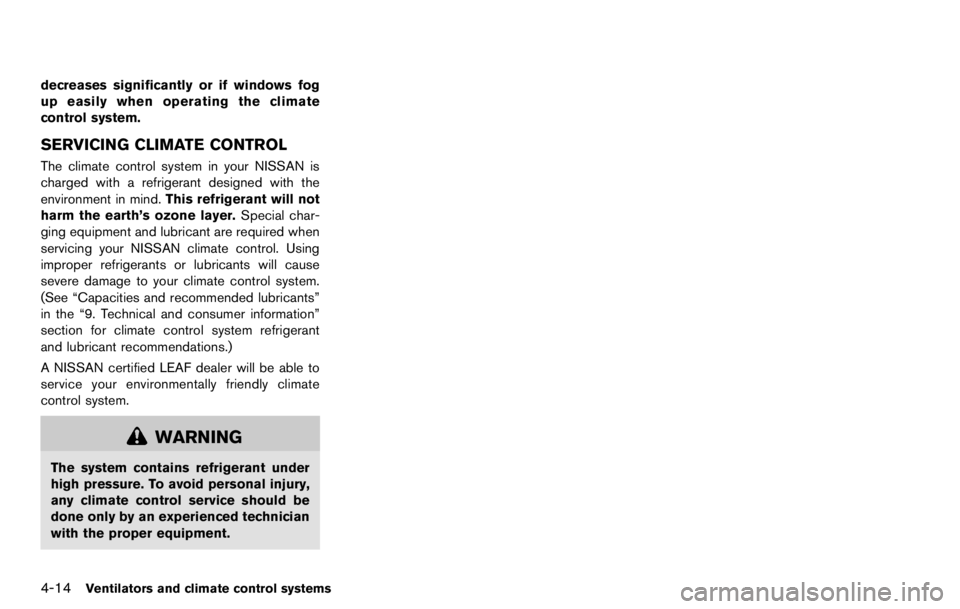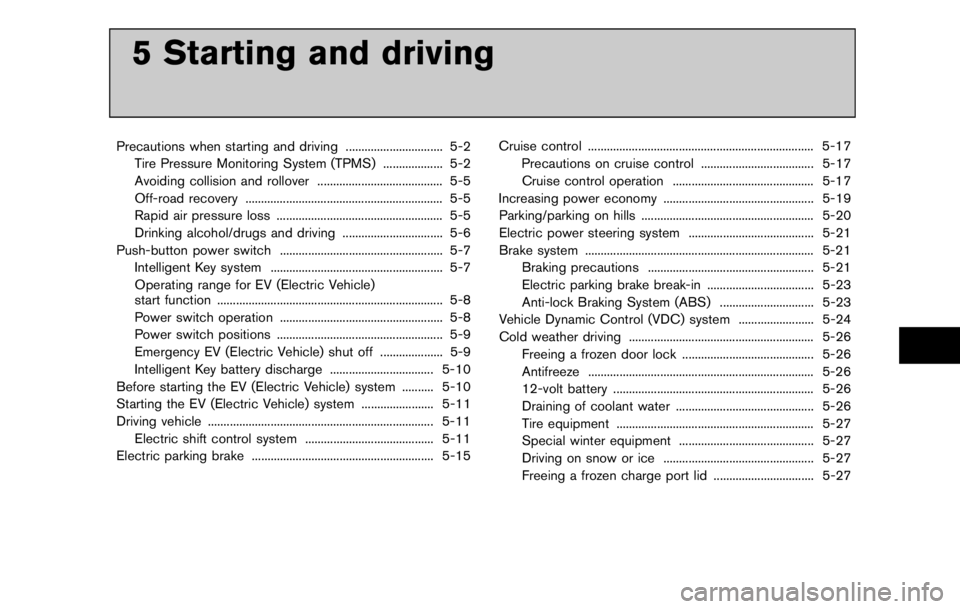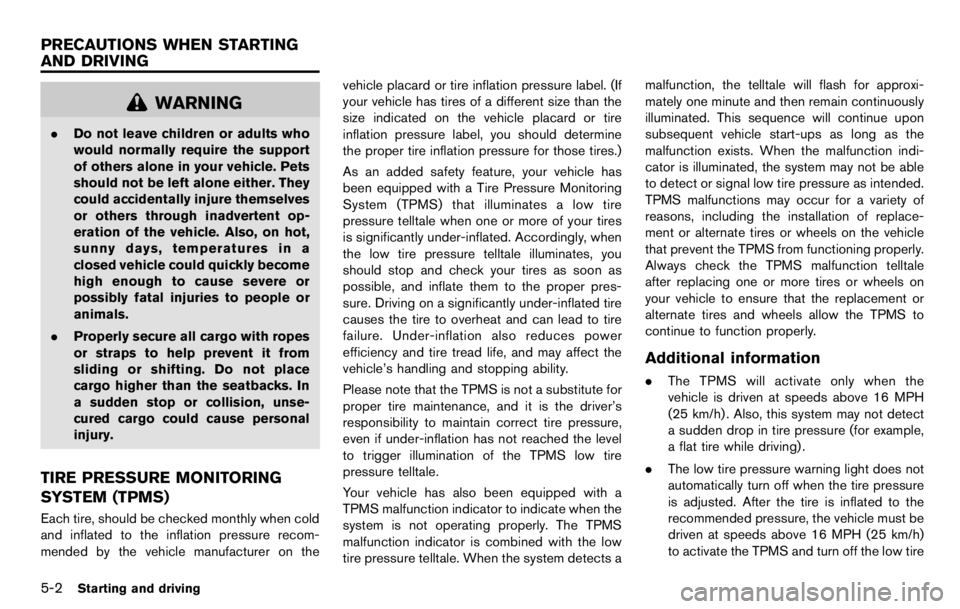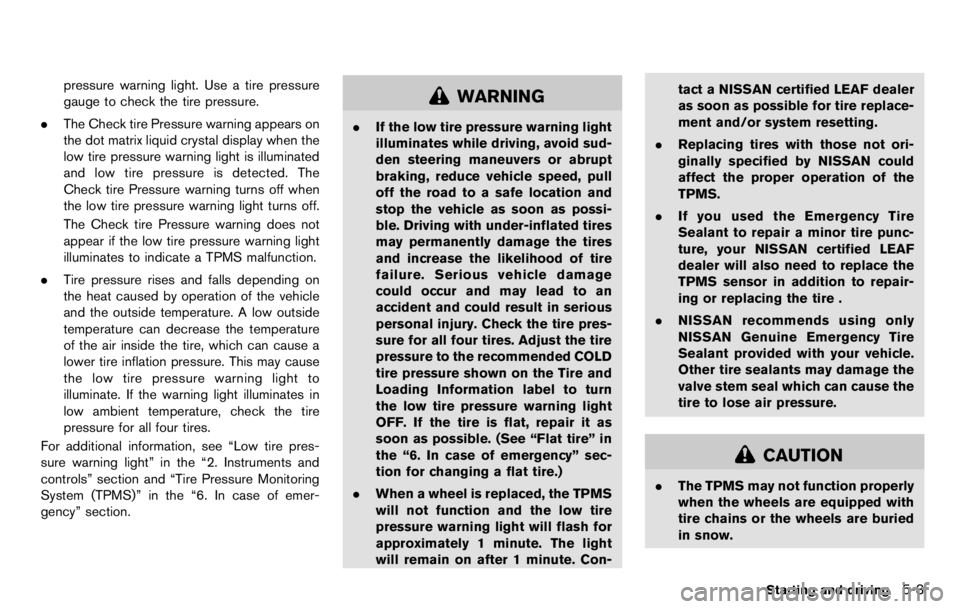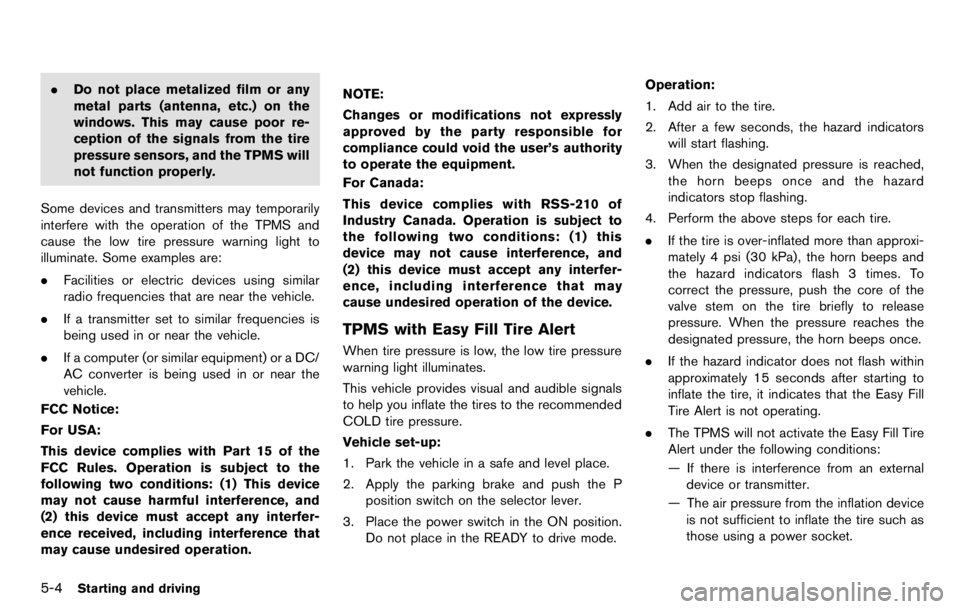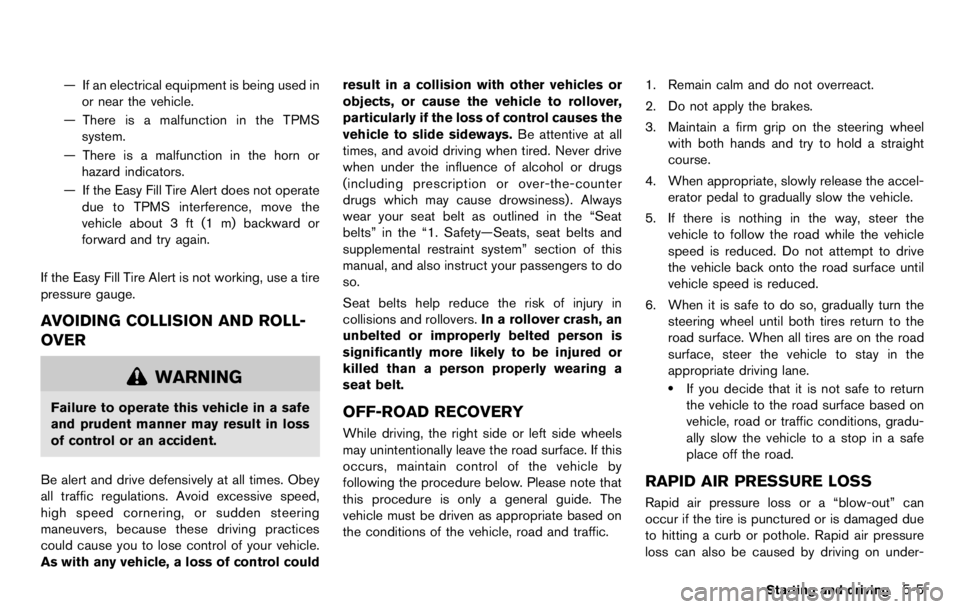illuminates, traction motor output is
limited resulting in reduced vehicle speed.
Stop the vehicle in a safe location before the
Li-ion battery becomes completely dis-
charged and there is no power available to
drive the vehicle. Contact Roadside assis-
tance service shown in your NISSAN
Warranty Information Booklet. See “If the
Li-ion battery becomes completely dis-
charged” in the “6. In case of emergency”
section.
CHARGING THE 12-VOLT BATTERY
The 12-volt battery is charged automatically
using electricity stored in the Li-ion battery.
When the 12-volt battery is being charged, the
charge status indicator light on the instrument
panel flashes. (except when charging the Li-ion
battery or the power switch is in the READY to
drive position.) See “Charging status indicator
lights” in the “CH. Charging” section.
While vehicle is in use
The Li-ion battery charges the 12-volt battery as
necessary when the power switch is in the
READY to drive position or ON position.
The 12-volt battery is not charged in the
following conditions.
.When the power switch is in ACC position.
. When the power switch is in ON position
and shift position is in the N (Neutal)
position.
While the vehicle is not in use
When the EV (Electric Vehicle) system is off for
an extended time, the 12-volt battery may be
automatically charged for a short period of time
on a regular basis.
LI-ION BATTERY HEATER
CAUTION
The Li-ion battery heater does not
operate if the available Li-ion battery
charge is less than approximately 30%
and the charger is not connected to the
vehicle. To help prevent the Li-ion
battery from freezing, do not leave the
vehicle in an environment if tempera-
tures may go below -48F (-208C) unless
the vehicle is connected to a charger.
The Li-ion battery heater helps to prevent the Li-
ion battery from freezing and helps to prevent
significant reductions in the Li-ion battery output
when the temperature is cold. The Li-ion battery
heater automatically turns on when the Li-ion
battery temperature is approximately -48 F
(-208C) or colder. The Li-ion battery heater
automatically turns off when the Li-ion battery
temperture is approximately 148F (-108C) or
higher.
The Li-ion battery heater uses electrical power
from an external source when a charger is
connected to the vehicle. The Li-ion battery
heater uses electrical power from the Li-ion
battery when the charger is not connected to the vehicle.
NOTE:
.
Connect the charger to the vehicle and
place the power switch in the OFF
position when parking the vehicle if
temperatures may go below -48 F
(-208C) . This provides external power
to the Li-ion battery heater when it
operates and does not discharge the
Li-ion battery.
. The charging status indicator lights
illuminate in a specific pattern when
the Li-ion battery heater operates. The
charging status indicator lights use the
same pattern to indicate 12-volt battery
charging, Climate Ctrl. Timer operation
or Remote Climate Control operation.
The charging status indicator lights do
not change if the Li-ion battery heater
operates at the same time as the above
features. See “Charging status indica-
tor lights” in the “CH. Charging” sec-
tion.
. The Li-ion battery heater uses Li-ion
battery power to operate, even if the
vehicle is connected to a charger when:
EV OverviewEV-5
WARNING
.The EV (Electric Vehicle) system
uses high voltage up to approxi-
mately DC 400 volt. The system can
be hot during and after starting and
when the vehicle is shut off. Be
careful of both the high voltage
and the high temperature. Follow
the warning labels that are attached
to the vehicle.
. Never disassemble, remove or re-
place high-voltage parts and cables
as well as their connectors because
they can cause severe burns or
electric shock that may result in
serious injury or death. High-voltage
cables are colored orange. The
vehicle high voltage system has no
user serviceable parts. Take your
vehicle to a NISSAN certified LEAF
dealer for any necessary mainte-
nance.
WARNING
In case of a collision:
.If your vehicle is drivable, pull your
vehicle off the road, push the P
(Park) position switch on the selec-
tor lever, apply the parking brake
and turn the EV (Electric Vehicle)
system off.
. Check your vehicle to see if there
are exposed high-voltage parts or
cables. For their locations, see
“High-voltage components” earlier
in this section. To avoid personal
injury, never touch high-voltage wir-
ing, connectors, and other high-
voltage parts, such as inverter unit
and Li-ion battery. An electric shock
may occur if exposed electric wires
are visible when viewed from inside
or outside of your vehicle. There-
fore, never touch exposed electric
wires.
. If the vehicle receives a strong
impact to the floor while driving,
stop the vehicle in a safe location
and check the floor. .
Leaks or damage to the Li-ion
battery may result in a fire. If you
discover them, contact emergency
services immediately. Since the
fluid leak may be lithium manga-
nate from the Li-ion battery, never
touch the fluid leak inside or out-
side the vehicle. If the fluid contacts
your skin or eyes, wash it off
immediately with a large amount of
water and receive immediate medi-
cal attention to help avoid serious
injury.
. If a fire occurs in the EV (Electric
Vehicle) , leave the vehicle as soon
as possible. Only use a type ABC,
BC or C fire extinguisher that is
meant for use on electrical fires.
Using a small amount of water or
the incorrect fire extinguisher can
result in serious injury or death from
electrical shock.
. If your vehicle needs to be towed,
do it with the front wheels raised. If
the front wheels are on the ground
when towing, the traction motor
may generate electricity. This may
damage the components of the EV
(Electric Vehicle) system and cause a fire.
. If you are not able to safely assess
the vehicle due to vehicle damage,
do not touch the vehicle. Leave the
vehicle and contact emergency ser-
vices. Advise 1st responders that
this is an electric vehicle.
. In the event of an accident that
requires body repair and painting,
the vehicle should be delivered to a
NISSAN certified LEAF dealer to
have the Li-ion battery pack and
high voltage parts such as the
inverter, including the wiring har-
ness, removed prior to painting. Li-
ion battery packs exposed to heat in
the paint booth will experience
capacity loss. Damaged Li-ion bat-
tery packs may also pose safety
risks to untrained mechanics and
repair personnel.
ROAD ACCIDENT PRECAUTIONS
